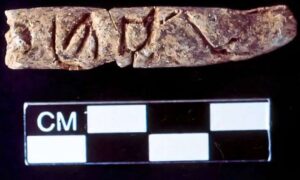Today, people often vent their frustration at others publicly on social media, or privately via angry WhatsApp messages. Archaeologists in Germany have uncovered the 15th-century version. Here, poisonous feelings were expressed as a curse inscribed into a lead tablet and buried underground.
The piece of metal turned up beneath a construction site in Rostock, in extreme northern Germany. The worn message read, “sathanas taleke belzebuk hinrik berith.” The words summoned Satan to curse a woman, Taleke, and a man, Hinrik. A jilted lover’s curse, perhaps?
Engraved culture
Tablets reveal a huge amount about ancient cultures. For example, finds have unveiled lost languages from ancient Turkey and the secrets of Easter Island. Curse tablets are commonly associated with ancient Greece and Rome, but finds from Northern Europe are very rare.

The ancient city of Alacahoyuk, where tablets revealed an undiscovered language. Corum, Turkey. Photo: Shutterstock
As an easy way of inscribing messages, tablets can reveal what mattered most to ordinary people. For example, archaeologists found 30 lead tablets from a public well in Athens, engraved with curses. People pierced them with nails or sculpted these 2,300-year-old curses into the shape of livers or coffins. Some contained common grievances, and again, the jilted lover is a theme. One tablet condemned a promiscuous newlywed called Glykera.
Bath, England — the site of the famous ancient spas of Roman Britain — holds a similar collection of curse tablets. They depict the vengeful wishes of those who have suffered an injustice over theft, lying, or cheating. Both the ancient Roman and Greek cultures believed that proximity to water would carry their curses to the gods of the underworld.
This latest find in Germany is only 500 years old and is one of the first of its kind from northern Europe. This suggests that the ordinary European’s Christian life was also wrapped up in a world of magic, mysticism, and curses.
A symbolic latrine, or just a place to hide?!
Oddly, the artifact lay at the bottom of a latrine. The symbolic significance of this is unknown, but clearly, the protagonist thought this the best place to hide his or her curse, so that its malign influence on the couple would go undisturbed.






